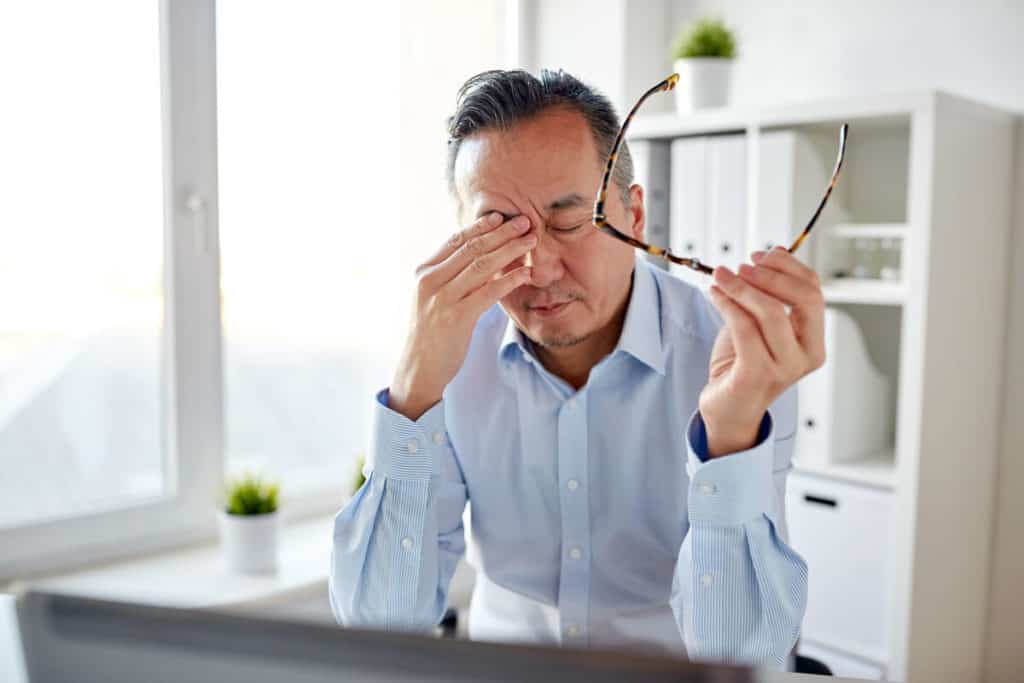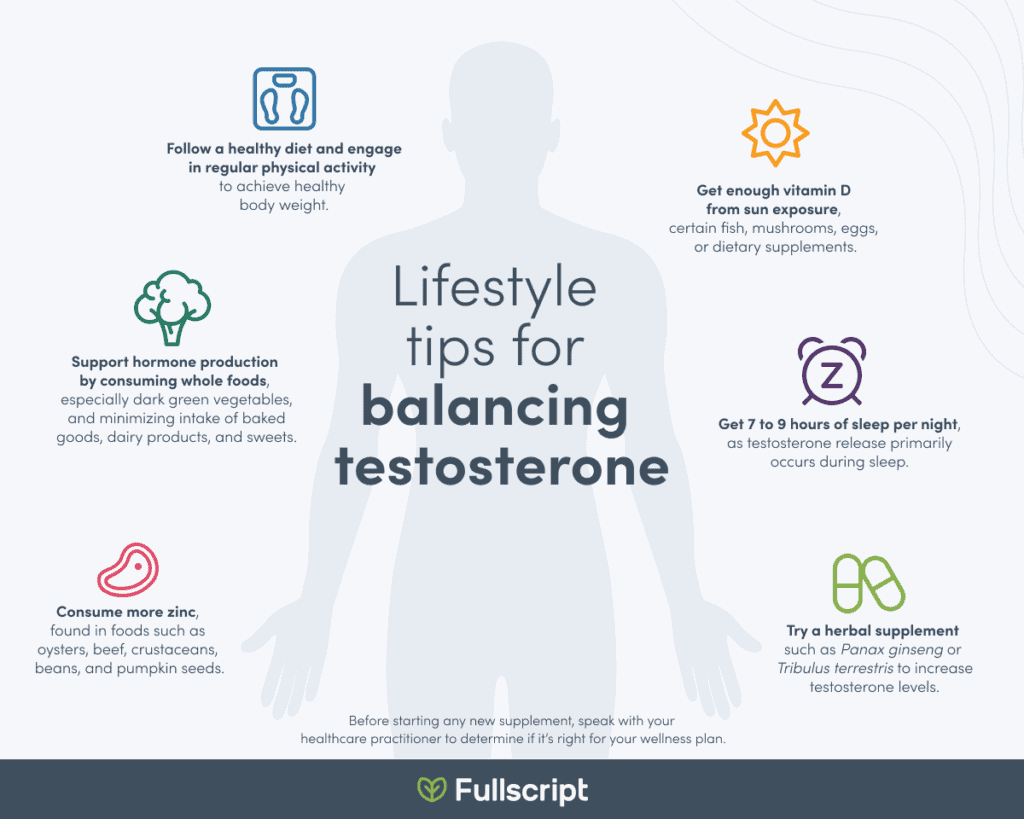
What is testosterone?
Testosterone is a hormone made in the testes and it’s the most important reproductive hormone in men. In fact, it’s the hormone responsible for a man’s deep voice and facial hair. However, the role of this hormone extends beyond your reproductive health or masculine features. Testosterone also supports healthy bones, muscle mass, and blood cell production, and can even affect where you store body fat. (4)(11)(21) A small amount of the testosterone circulating in your bloodstream is also converted to a type of estrogen called estradiol. In men, estradiol is essential for modulating libido, erectile function, and the production of sperm. (28) As your body produces less testosterone, you also make less estradiol. This can cause changes that are often attributed to low testosterone levels. (21)Did you know? Testosterone is part of a group of hormones known as androgens. Other androgens include dihydrotestosterone (DHT) and dehydroepiandrosterone (DHEA). While androgens are typically considered “male” hormones, they also play an important role in women’s health. (30)
What causes hormonal imbalance in men?
Male hypogonadism—the medical term for low testosterone levels—occurs when the body doesn’t make enough testosterone. The two basic types of hypogonadism are primary and secondary. (16) Primary hypogonadism occurs when the testes don’t produce enough testosterone to support optimal health. (16) This can be an inherited condition, such as when the testicles don’t descend before birth or when a man is born with three sets of the sex chromosomes X and Y, a condition known as Klinefelter syndrome. (3) Other causes of primary hypogonadism include:- A mumps infection affecting the testicles
- Chemotherapy or radiation treatment
- Excess iron in the blood
- Injury to the testicles (16)
- Abnormal development of the hypothalamus
- An inflammatory disease, such as sarcoidosis or tuberculosis
- A problem with the pituitary gland
- Certain medications, such as opioids and steroids
- HIV/AIDS
- Obesity
- Stress (16)
Symptoms of a testosterone imbalance
Both primary and secondary hypogonadism present with similar symptoms in adult men, including:- Anemia
- Changes in cholesterol levels
- Decreased energy and stamina
- Depression
- Difficulty concentrating
- Diminished muscle mass
- Enlargement of breasts
- Erectile dysfunction
- Hot flashes
- Irritability
- Loss of body hair
- Osteoporosis
- Problems attaining an orgasm
- Reduced libido
- Weight gain (16)(22)
Diagnosing and treating a testosterone imbalance
The presence of the symptoms listed above can be an indication of a hormonal imbalance. To verify this, your integrative healthcare practitioner may conduct a physical examination and order blood tests to measure hormones such as total/free testosterone, estrogen, progesterone, luteinizing hormone (LH), prolactin, and sex hormone binding globulin (SHBG), as these factors can affect your testosterone levels. (5)(20)(33) Normal testosterone levels in men range from 264 to 916 ng/dL. (31) If your levels are below 300 ng/dL, your practitioner may order additional tests to determine the underlying cause. (5) The standard treatment for low testosterone levels is testosterone replacement therapy. While this type of treatment may improve mood, bone mineral density, muscle mass, libido, and the ability to achieve and maintain an erection, it can also come with potential side effects, such as liver toxicity or exacerbation of other conditions, including benign prostatic hyperplasia (BPH or enlarged prostate) and cardiovascular issues. (2)(5) Additionally, there are many things you can do to balance your hormone levels naturally.
Lifestyle tips for balancing testosterone
Incorporating the following lifestyle changes not only helps balance testosterone levels, they can also enhance your overall health and well-being.Aim for a healthy body weight
Studies report that overweight men who lose weight often experience the positive side effect of increased testosterone levels. A 2018 clinical trial, involving 105 obese men from a fertility clinic with an average body mass index (BMI) of 33.2 kg/m2, found that those who lost weight and reduced their BMI to an average of 30.4 kg/m2 experienced an increase in testosterone production after one year. (15) Since then, other studies have supported these findings, including one review of 24 clinical studies that appeared in the European Journal of Endocrinology. During their analysis, the reviewers found that weight loss, either through diet or bariatric surgery, increased both total and free testosterone in men. (1)(7)(12)Follow a healthy diet
Interestingly, some data also shows that the type of diet you follow can affect testosterone levels. In a study of data from more than 3,100 men using the National Health and Nutrition Examination Survey, researchers found that both low-fat and Mediterranean-style diets were associated with slightly lower than average testosterone levels. (10) According to one study in women, healthy fats like avocados or olive oil support the production of hormones, including testosterone, which may in part explain these results. (23) So it’s important to speak with your integrative health practitioner about which type of diet might be best for you.Consume more zinc
Zinc is an essential mineral for balancing testosterone levels and maintaining the health and integrity of sperm. (9) Since your body can’t store zinc, deficiency of this mineral is common. However, one small study conducted at Wayne State University in Detroit found that correcting a zinc deficiency doubled testosterone production in elderly men. (27) Easy ways to ensure you’re consuming enough zinc is by eating more zinc-rich foods, including red meat, shellfish, nuts and seeds, dairy, and legumes. (24)Add some vitamin D
Increasing your intake of the sunshine vitamin may help increase your testosterone levels and improve sperm quality. (32) One study involving 165 male participants reported that the men taking a daily dose of supplemental vitamin D experienced a significant increase in their testosterone levels. (26)Get enough sleep
According to a study in the Journal of the American Medical Association, even five days of sleep deprivation can cause a 10% to 15% drop in a man’s testosterone levels. (17) Strive to get the recommended seven to nine hours of shuteye every night to support a healthy testosterone balance. (29)Try a herbal supplement
Pairing healthier habits with a supplement providing medicinal herbs such as Panax ginseng, Tribulus terrestris, and Lepidium meyenii (maca) can support hormonal balance and better overall sexual health in men. Studies show that Panax ginseng and Tribulus terrestris elevate testosterone levels. (8)(18) Maca, on the other hand, doesn’t impact a man’s hormonal balance but can enhance libido and support sexual function. (13) Before starting any new supplement, speak with your healthcare practitioner to determine if it’s right for your wellness plan.
The bottom line
Testosterone plays an important role in maintaining bone health, muscle mass, weight, and mood. If you suspect you’re suffering from a testosterone imbalance, adopting the diet and lifestyle tips above may help. It’s also important to speak with your integrative healthcare practitioner to determine your hormonal status and develop a plan to maximize your health and vitality.- Armamento-Villareal, R., Aguirre, L.E., Quails, C., & Villarieal, D.T. (2016). Effect of lifestyle intervention on the hormonal profile of frail, obese older men. Journal of Nutrition, Health & Aging, 20(3), 334-340.
- Bassil, N., Alkaade, S., & Morley, J.E. (2009). The benefits and risks of testosterone replacement therapy: a review. Therapeutics and Clinical Risk Management, 5(3), 427-448.
- Bearelly, P. & Oates, R. (2019). Recent advances in managing and understanding Klinefelter syndrome. F1000 Research, 8, F1000 Faculty Rev-112.
- Beggs, L.A., Yarrow, J.F., Conover, C.F., Meuleman, J.R., Beck, D.T., Morrow, M., Zou, B., … Borst, S.E. (2014). Testosterone alters iron metabolism and stimulates red blood cell production independently of dihydrotestosterone. American Journal of Physiology, Endocrinology and Metabolism, 307(5), E456-E461.
- Carnegie, C. (2004). Diagnosis of hypogonadism: clinical assessments and laboratory tests. Reviews in Urology, 7(Suppl 6), S3-S8.
- Cohen, J., Nassau, D.E., Patel, P, & Ramasamy, R. (2019). Low testosterone in adolescents & young adults. Frontiers in Endocrinology, 10, 916.
- Corona, G., Rastrelli, G., Monami, M., Saad, F., Luconi, M., Lucchese, M., Facchiano, E., … Maggi, M. (2013). Body weight loss reverts obesity-associated hypogonadotrophic hypogonadism: a systemic review and meta-analysis. European Journal of Endocrinology, 168(6), 829-843.
- El Din, S.F.G., Salam, M.A.A., Mohamed, M.S., Ajhmed, A.R., Motawaa, A.T., Saadeldin, O.A., & Elnabarway, R.R. (2019). Tribulus terrestris versus placebo in the treatment of erectile dysfunction and lower urinary tract symptoms in patients with late-onset hypogonadism: a placebo-controlled study. Urologia, 86(2), 74-78.
- Fallah, A., Mohammad-Hasani, A., & Colagar, A.H. (2018). Zinc is an essential element for male fertility: a review of Zn roles in men’s health, germination, sperm quality, and fertilization. Journal of Reproduction & Infertility, 19(2), 69-81.
- Fantus, R.J., Halpern, J.A., Chang, C., Keeter, M.K., Bennett, N.E., Helfand, B., & Brannigan, R.E. (2020). The association between popular diets and serum testosterone among men in the United States. The Journal of Urology, 203(2), 398-404.
- Finkelstein, J.S., Lee, H., Burnett-Bowie, S.M., Pallais, J.C., Yu, E.W., Borges, L.F., Jones, B.F., … Leder, B.Z. (2013). Gonadal steroids and body composition, strength, adn sexual function in men. New England Journal of Medicine, 369(11), 1011-1022.
- Giagulli, V.A., Castellana, M., Murro, I., Pelusi, Ca., Guastamacchia, E., Triggiani, V., & De Pergola, G. (2019). The role of diet and weight loss in improving secondary hypogonadism in men with obesity with or without type 2 diabetes mellitus. Nutrients, 11(12), 2975.
- Gonzales, G.F., Cordova, A., Vega, K., Chung, A., Villena, A., & Gonez, C. (2003). Effect of Lepidium meyenii (Maca), a root with aphrodisiac and fertility-enhancing properties, on serum reproductive hormone levels in adult healthy men. Journal of Endocrinology, 176, 163-168.
- Harman, S.M., Metter, E.J., Tobin, J.D., Pearson, J., & Blackman, M.R. (2001). Longitudinal effects of aging on serum total and free testosterone levels in healthy men. The Journal of Clinical Endocrinology & Metabolism, 86(2), 724-731.
- Jaffar, M., Andrabi, S.W., Prakash, B., & Subramani S.A. (2018). Impact of weight loss on reproductive hormones in obese men. International Journal of Infertility and Fetal Medicine, 9(3), 32-36.
- Kumar, P., Kumar, N., Thakur, D.S., & Patidar, A. (2010). Male hypogonadism: symptoms and treatment. Journal of Advanced Pharmaceutical Technology & Research, 1(3), 297-301.
- Leproult, R. & Van Cauter, E. (2011). Effect of 1 week of sleep restriction on testosterone levels in young healthy men FREE. Journal of the American Medical Association, 305(21). 2173-2174.
- Leung, K.W. & Wong, A.S.T. (2013). Ginseng and male reproductive function. Spermatogenesis, 3(3), e26391.
- Medline Plus. Hormones. https://medlineplus.gov/hormones.html
- Medline Plus. (2020). SGBG blood test. https://medlineplus.gov/lab-tests/shbg-blood-test/
- Mohamad, N., Soelaiman, I., & Chin, K. (2016). A concise review of testosterone and bone health. Clinical Interventions in Aging, 11, 1317-1324.
- Mulligan, T., Frick, M.F., Zuraw, Q.C., Stemhagen, A., & McWhirter, C. (2006). Prevalence of hypogonadism in males aged at least 45 years: the HIM study. International Journal of Clinical Practice, 60(7), 762-769.
- Mumford, S.L., Chavarro, J.E., Zhang, C., Perkins, N.J., Sjaarda, L.A., Pollack, A.Z., Schliep, K.C., … Wactawski-Wende, J. (2016). Dietary fat intake and reproductive hormone concentrations and ovulation in regularly menstruating women. American Journal of Clinical Nutrition, 103(3), 868-877.
- National Institutes of Health. (2020). Zinc. https://ods.od.nih.gov/factsheets/Zinc-HealthProfessional/
- Nedresky, D. & Singh, G. (2020). Physiology, luteinizing hormone. NCBI Bookshelf, StatPearls. https://www.ncbi.nlm.nih.gov/books/NBK539692/
- Pilz S., Frisch, S., Koertke, H., Kuhn, J., Dreier, J., Obermayer-Pietsch, B., Wehr, E., & Zittermann, A. (2011). Effect of vitamin D supplementation on testosterone levels in men. Hormone and Metabolic Research, 43(3), 223-225.
- Prasad, A.S., Mantzoros, C.S., Beck, F.W., Hess, J.W., & Brewer, G.J. (1996). Zinc status and serum testosterone levels in healthy adults. Nutrition, 12(5), 344-348.
- Schulster, M., Bernie, A.M., & Ramasamy, R. (2016). The role of estradiol in male reproductive function. Asian Journal of Andrology, 18(3), 435-440.
- Sleep Foundation. (2015). National sleep foundation recommends new sleep times. https://www.sleepfoundation.org/press-release/national-sleep-foundation-recommends-new-sleep-times
- Sowers, M.F., Beebe, J.L., McConnell, D., Randolph, J., & Jannausch, M. (2001). Testosterone concentrations in women aged 25-50 years: associations with lifestyle, body composition, and ovarian status. American Journal of Epidemiology, 153(3), 256-264.
- Travison, T.G., Vesper, H.W., Orwoll, E., Wu, F., Kaufman, J.M., Wang, Y., Lapauw, B., … Bhasi, S. (2017). Harmonized reference ranges for circulating testosterone levels in men of four cohort studies in the United States and Europe. The Journal of Clinical Endocrinology & Metabolism, 102(4), 1161-1173.
- Wehr, E., Pliz, S., Boehm, B.O., März, W., & Obermayer-Pietsch, B. (2010). Association of vitamin D status with serum and androgen levels in men. Clinical Endocrinology, 73(2):243-248.
- Xu, Z., Pan, D., Liu, T., ,Yuan, M., Zhang, J., Jiang, S., Wang, S.J., … Zhao, S. (2019). Effect of prolactin on penile erection: a cross-sectional study. Asian Journal of Andrology. 21(6), 587-591.





